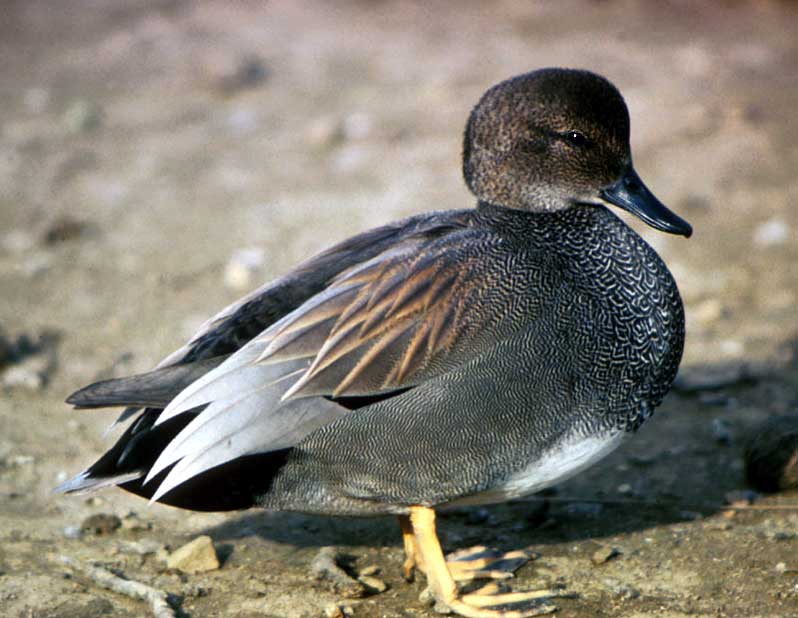
Gadwall(Anas strepera)
Phylum —chordata
Class — aves
Order — anseriformes
Family — anatidae
Genus –anas
Appearance
The gadwall is 46–56 cm (18–22 in) long with a 78–90 cm (31–35 in) wingspan. The male is slightly larger than the female, weighing on average 990 g (35 oz) against her 850 g (30 oz). The breeding male is patterned grey, with a black rear end, light chestnut wings, and a brilliant white speculum, obvious in flight or at rest. In non-breeding (eclipse) plumage, the drake looks more like the female, but retains the male wing pattern, and is usually greyer above and has less orange on the bill.
The female is light brown, with plumage much like a female mallard. It can be distinguished from that species by the dark orange-edged bill, smaller size, the white speculum, and white belly. Both sexes go through two moults annually, following a juvenile moult.
Habitat
The gadwall is a migratory bird. It winters from southern Mexico and Guatemala to coastal Alaska, the Atlantic, and Gulf coast regions of the United States and many areas in-between. Their summer breeding grounds range from the Atlantic coast of Canada to as far north as the western coastal regions of Alaska.
Behavior
The gadwall is a bird of open wetlands, such as prairie or steppe lakes, wet grassland or marshes with dense fringing vegetation, and usually feeds by dabbling for plant food with head submerged. It nests on the ground, often some distance from water. It is not as gregarious as some dabbling ducks outside the breeding season and tends to form only small flocks. This is a fairly quiet species.
Diet
Gadwalls main food sources are aquatic vegetation, aquatic invertebrates, and seeds. Their main diet of plant material includes leaves and stems of aquatic plants. Gadwalls will also supplement their plant diet with insects, crustaceans, amphibians, mollusks, and fish. Females will eat a protein and fat rich diet prior to mating. This provide them with extra resources for the egg laying and incubation periods.
Reproduction
Gadwalls are monogamous in their breeding behavior. Pairs of adult birds will bond in the mid to late fall, while immature birds will pair by mid-winter. Pair bonds are renewed each year.The breeding season will vary but usually can occur in May and go through mid-July.
The male and the female will fly low over meadows and upland habitat in search of a nesting site. The female will usually choose a nest site near her natal nesting grounds. As the male stands guard, the female will inspect an area that has suitable materials for nest building. When an area has been chosen, the female constructs a nest bowl by scraping a depression in the soil. She then lines it with leaves, grasses, and twigs from nearby material. She may then line the nest with down feathers plucked from her body.
Female will lay a clutch from 7 to 13 eggs at the rate of one egg per day. The average incubation period will last 26 days with the female spending 85% of her time on the eggs. Many males will abandon the female after the clutch is laid and to a safe area where they will molt to their basic plumage.
The precocial young will hatch and be led by their mother from the vulnerable nest area to brood-rearing habitat. Since the ducklings are precocial, they obtain their own food. The female will raise the brood for no more than 10 weeks and will then abandon her young.
In captivity
The average lifespan in captivity is up to 15 years.
These birds do not need special conditions for breeding. In food, they are also unpretentious: they do not need special food. You do not need to equip the cages additionally, heating of the poultry house is not required. This is due to the fact that wild animals are less whimsical.
You do not need to buy an incubator; at any time of the year a brick building is suitable for birds. To make the birds feel comfortable, you need to make a pen with a net. Ducks can survive at low temperatures, even in frosts, wild birds feel great.
In the poultry house, you need to choose and arrange three places: for ducklings, for laying hens and a drake, and grown individuals. There are usually two families of 3-4 laying hens and one drake. Such a herd will bring you eggs. In the poultry house should be not only feeders, but also drinkers, otherwise the birds will look for their own water. Containers for water and feed are also installed on the paddock. If it rains or gets hot outside, the birds hide themselves in the shelter. It is necessary to build a canopy for this purpose.
In summer, birds are provided with a place to swim. It can be a small pond. For ducks, summer is the bathing season. Water should also be in the drinking bowl. This rule is fulfilled during all months. The water tank must always be full. Only clean, fresh water is suitable for birds.
Wild birds extract small fish from reservoirs. It is recommended to add it to their diet. You can feed both mixed feed and vegetable mixes. Mineral supplements and vitamins play an important role in the diet of ducks. Vitamin supplements and minerals are added to the mixers. In separate feeders are filled with ground seashell, gravel and chalk.
 Russian
Russian
 English
English
























